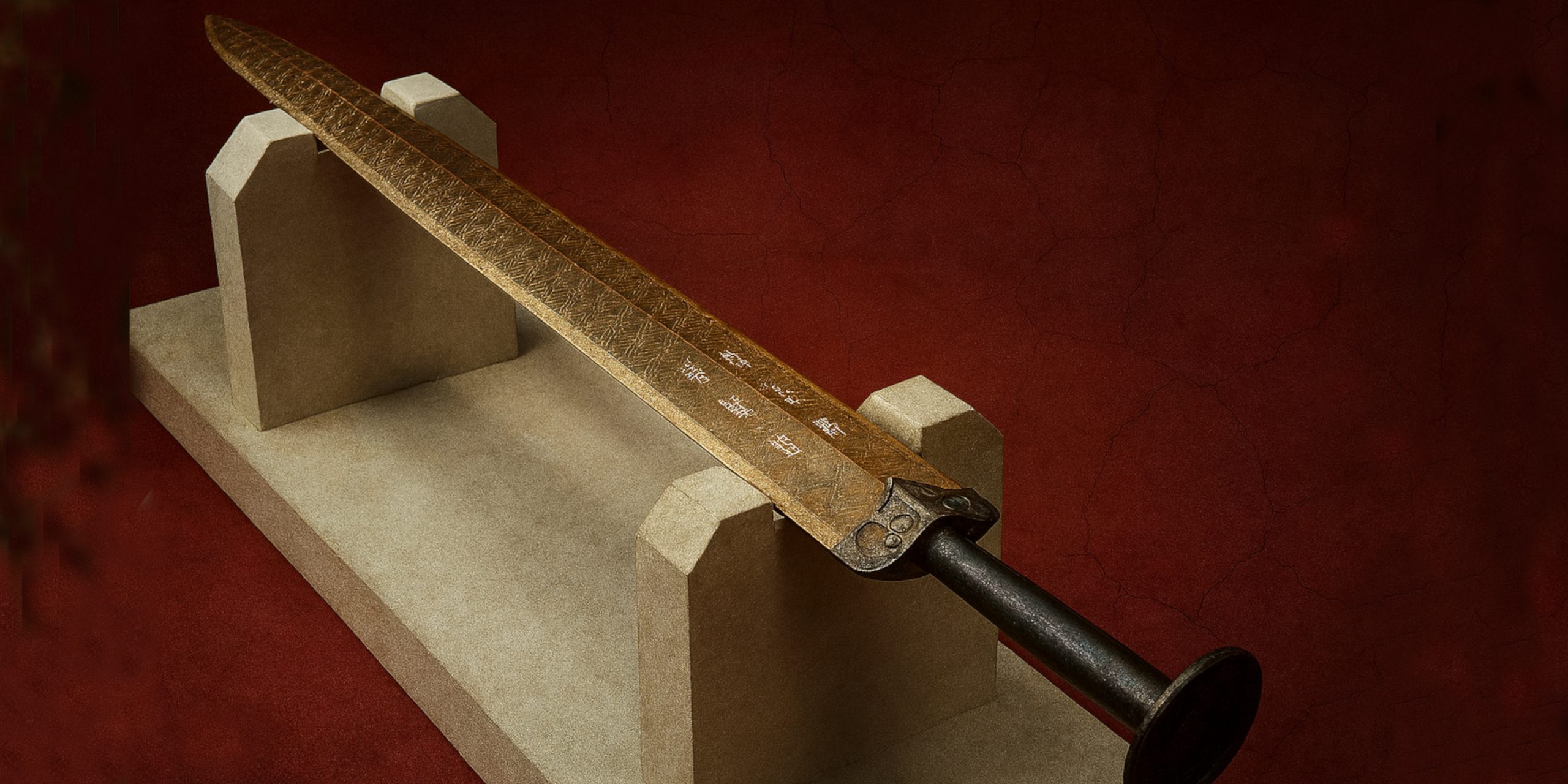
The Goujian Sword is one of the most famous archaeological finds in Chinese history, notable for its exceptional craftsmanship, remarkable preservation, and cultural significance. Discovered in 1965 in Hubei Province, the sword is believed to date back over 2,000 years to the Spring and Autumn period of Chinese history, traditionally associated with the state of Yue and its ruler King Goujian. Despite being buried for centuries, the blade remains sharp and untarnished, a testament to advanced ancient metallurgy.
Specifications
| Feature | Detail |
|---|---|
| Origin | State of Yue, Spring and Autumn Period (771–476 BCE) |
| Length | Approximately 55.6 cm |
| Blade Width | About 4.6 cm |
| Weight | Around 875 grams |
| Material | High-tin bronze alloy |
| Decoration | Black rhombi pattern on blade, blue crystals and turquoise on guard |
| Inscription | “King of Yue made this sword for his personal use” (ancient Chinese script) |
| Condition | Exceptionally well-preserved, minimal tarnish |
History and Evolution
- Believed to have been commissioned by King Goujian of Yue in the late 6th to early 5th century BCE.
- Goujian is remembered as a ruler who overcame defeat to later conquer his rivals, particularly the State of Wu.
- The sword’s alloy composition shows a sophisticated understanding of metallurgy, combining copper and tin in varying ratios for strength, flexibility, and corrosion resistance.
- Burial in an air-tight lacquered wooden case helped preserve the weapon for over two millennia.
- The sword represents the peak of ancient Chinese bronze weapon-making before the widespread adoption of iron.
Advantages and Disadvantages
Advantages
- Remarkable corrosion resistance due to alloy composition and protective design.
- Fine balance and manageable weight, allowing for both thrusting and slashing.
- Ornate craftsmanship signalling high status and ceremonial use as well as combat function.
- Sharpness and edge retention superior to many other bronze-age weapons.
Disadvantages
- Bronze, while durable, is less effective against later iron and steel weapons.
- Decorative elements may reduce practicality in prolonged battlefield use.
- Length limits reach compared to longer swords and spears of the period.
Comparison with Similar Weapons
| Feature / Weapon | Goujian Sword | Typical Warring States Bronze Sword | Early Chinese Iron Sword |
|---|---|---|---|
| Material | High-tin bronze | Bronze alloy | Iron |
| Length | Medium (55.6 cm) | Varies (50–70 cm) | Often longer (60–80 cm) |
| Corrosion Resistance | Excellent | Good | Poor without proper maintenance |
| Ornamentation | High | Moderate | Low to moderate |
| Combat Effectiveness | High for period | High for period | Higher penetration capability |
Legacy
The Goujian Sword has become an iconic symbol of Chinese heritage, representing both technological advancement and the resilience associated with King Goujian’s story. It is often cited in discussions of ancient Chinese metallurgy, craftsmanship, and archaeology. Its exceptional preservation has made it a subject of scientific study, inspiring metallurgy research and exhibitions worldwide.
Where to See the Goujian Sword
The original Goujian Sword is held at the Hubei Provincial Museum in Wuhan, China. It is displayed under controlled conditions to prevent deterioration. Replicas can be found in various Chinese museums and cultural exhibitions internationally.
Collector’s Guide
Collectibility
- Authentic ancient bronze swords from the Spring and Autumn or Warring States periods are highly sought after but extremely rare.
- Replicas of the Goujian Sword, often produced in bronze or stainless steel, are popular among collectors of Chinese history and weaponry.
Auction Prices
- Genuine period bronze swords (non-Goujian) can sell from £5,000 to £50,000 depending on condition, provenance, and decoration.
- Decorative high-quality replicas of the Goujian Sword range from £200 to £2,000.
- Authentic artefacts attributed to royal ownership or with inscriptions can fetch significantly higher prices, though such items are seldom released for private sale due to cultural heritage laws.
Buying Tips
- Verify authenticity through professional appraisal and metallurgical testing.
- Be cautious of modern reproductions passed off as originals.
- Ensure compliance with local and international cultural property regulations before purchase.
Watch the documentary:



